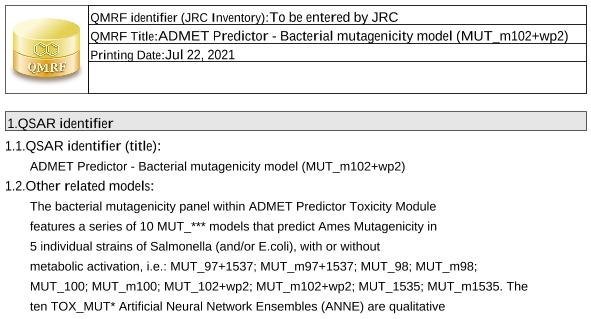Daga, P. ADMET Predictor - Bacterial mutagenicity model (MUT_m102+wp2). 2020.
QDB archive DOI: 10.15152/QDB.252 DOWNLOAD
QMRF document
Citing
When using this QDB archive, please cite (see details) it together with the original article:
-
Lawless, M. Data for: ADMET Predictor - Bacterial mutagenicity model (MUT_m102+wp2). QsarDB repository, QDB.252. 2021. https://doi.org/10.15152/QDB.252
-
Daga, P. ADMET Predictor - Bacterial mutagenicity model (MUT_m102+wp2). 2020.
Metadata
| Title: | Daga, P. ADMET Predictor - Bacterial mutagenicity model (MUT_m102+wp2). 2020. |
| Abstract: | MUT_m102+wp2 The Ames bacterial mutagenicity test is an important regulatory screen for potential carcinogenicity. In silico prediction of Ames positivity plays two important but somewhat distinct roles in the discovery and development of biologically active compounds. A positive Ames test does not necessarily derail development of an active ingredient (AI), because some bacterial mutagens are not carcinogenic. As a practical matter, however, demonstrating non-carcinogenicity is challenging enough that having a robust predictive model for Ames mutagenicity is a very cost-effective alternative to automatically testing every active compound, especially since the model can be used to help decide which particular compounds to synthesize or purchase. In addition, regulatory guidance now allows the use of in silico predictions of mutagenicity to help justify waiving Ames testing requirements for impurities; ADMET Predictor®’s MUT_Risk qualifies as a “statistical model” under ICH M7. MUT_m102+wp2 is one of the 11 models that provide input to MUT_Risk. It is an artificial neural network ensemble (ANNE) classification model built on literature data for 124 positive examples and 679 negative examples from Ames tests run using S. typhimurium TA102 or E. coli WP2 uvrA with metabolic activation by S9 cell fractions. Of those, 18 and 143, respectively, were set aside as an external test set for which the sensitivity was 0.889 and the specificity was 0.811 with an overall concordance of 0.820. The corresponding training set performance statistics were 0.802, 0.828, and 0.824. Predictions for any compounds for which any descriptor falls more than 10% outside the range of that descriptor seen in the training data are flagged as out-of-scope, and statistically rigorous confidences (doi 10.1186/1758-2946-6-34) are provided for all in-scope predictions. |
| URI: | http://hdl.handle.net/10967/252
http://dx.doi.org/10.15152/QDB.252 |
| Date: | 2021-09-02 |
Files in this item
| Name | Description | Format | Size | View |
|---|---|---|---|---|
| QMRF_ADMET_MUT_m102+wp2-v4.pdf | n/a | 40.15Kb | View/ |
|
| QMRF_ADMET_MUT_m102+wp2-v4.xml | n/a | application/qmrf-xml | 34.66Kb | View/ |

Files associated with this item are distributed
under Creative Commons license.
under Creative Commons license.
This item appears in the following Collection(s)
-
QMRFs for mutagenicity models
The QSAR Model Reporting Format (QMRF) documents for mutagenicity models.
